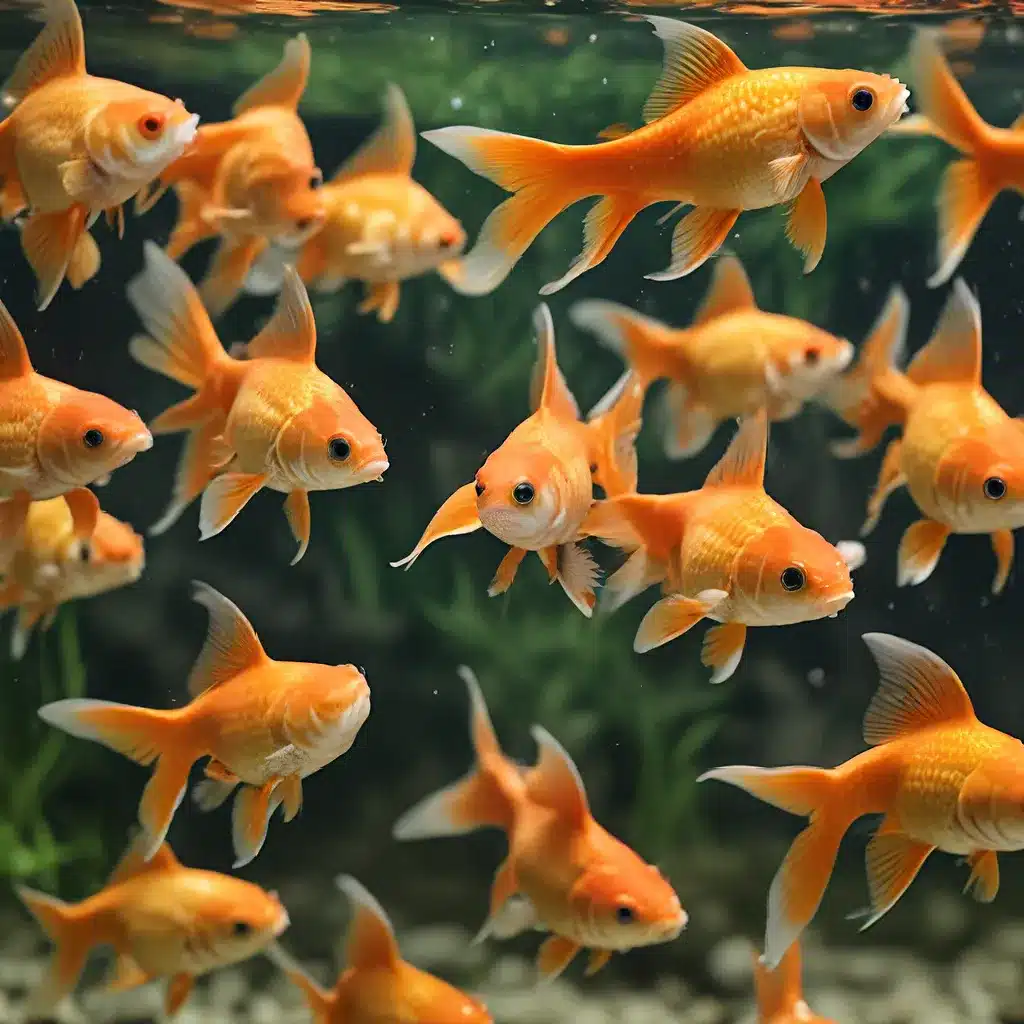
Understanding the Goldfish Aquarium
Goldfish, with their vibrant colors and playful personalities, have long been a beloved choice for aquarium enthusiasts. These hardy freshwater fish are not only visually stunning but also remarkably resilient, making them a popular selection for both beginner and experienced aquarists. However, providing the appropriate care and environment for goldfish can be more complex than one might expect.
Goldfish are social creatures that thrive in spacious aquariums or outdoor ponds, where they can freely explore and interact with their tankmates. Unlike some other aquarium fish, goldfish are omnivorous, meaning they require a balanced diet consisting of both plant-based and protein-rich foods. Maintaining optimal water parameters, such as temperature, pH, and dissolved oxygen levels, is crucial for the long-term health and well-being of these captivating aquatic companions.
Choosing the Right Goldfish Variety
When selecting goldfish for your aquarium, it’s important to consider the specific needs and characteristics of different varieties. The King Aquarium team recommends researching the various goldfish breeds to ensure you choose the ones that best suit your setup and personal preferences.
Common Goldfish, known for their robust nature and vibrant colors, are a popular choice for beginners and experienced aquarists alike. These fish can grow to impressive sizes and thrive in larger aquariums or outdoor ponds. In contrast, Fancy Goldfish, with their unique body shapes and intricate finnage, require more specialized care and a well-maintained environment to flourish.
When planning your goldfish aquarium, it’s also crucial to consider the tank size and stocking density. Goldfish are active swimmers and produce a significant amount of waste, necessitating a larger tank or pond to accommodate their needs and maintain optimal water quality.
Aquarium Design and Setup
Creating a thriving goldfish aquarium begins with the careful design and setup of the tank. Here are some key considerations:
Tank Size and Filtration: Goldfish require ample space to swim and grow, with a minimum tank size of 20 gallons for a single common goldfish. Fancy goldfish, on the other hand, may require even larger aquariums to accommodate their unique body shapes. A powerful filtration system is essential to maintain water quality and support the biological needs of your goldfish.
Substrate and Decorations: When it comes to the substrate, goldfish tend to thrive in a natural, planted environment. Opt for a fine-grained gravel or sand substrate that allows for easy waste removal and supports the growth of aquatic plants. Incorporate live plants, driftwood, and other decorative elements to create a visually appealing and enriching habitat for your goldfish.
Lighting and Water Parameters: Goldfish prefer moderate lighting conditions, as they can be sensitive to intense illumination. Maintaining the appropriate water temperature, pH, and dissolved oxygen levels is crucial for their overall health and well-being.
Goldfish Nutrition and Feeding
Providing a balanced and varied diet is essential for the long-term health and vibrant coloration of your goldfish. These omnivorous fish require a combination of plant-based and protein-rich foods.
Commercial Goldfish Flakes and Pellets: High-quality commercial goldfish food, such as flakes or pellets, should make up the foundation of your fish’s diet. Look for formulas that are specifically designed to meet the nutritional needs of goldfish.
Live and Frozen Foods: Supplement your goldfish’s diet with live or frozen foods, such as brine shrimp, bloodworms, and daphnia. These protein-rich treats not only provide essential nutrients but also stimulate the fish’s natural foraging behavior.
Vegetation and Greens: Include leafy greens, such as spinach or kale, as well as aquatic plants, to ensure your goldfish receive the necessary fiber and vitamins for a balanced diet.
Establish a consistent feeding schedule and avoid overfeeding, as excess food can lead to water quality issues and health problems in your goldfish.
Maintaining Water Quality and Health
Maintaining optimal water quality is a crucial aspect of goldfish care, as these fish are sensitive to fluctuations in water parameters. Regularly testing and adjusting the water chemistry, along with performing partial water changes, are essential for the long-term health and well-being of your goldfish.
Ammonia, Nitrite, and Nitrate: Closely monitor the levels of these key water parameters, as elevated concentrations can be toxic to your goldfish. Establish a robust filtration system and regularly maintain your tank’s biological balance to keep these levels in check.
Disease Prevention and Treatment: Familiarize yourself with common goldfish diseases, such as ich, fin rot, and swim bladder disorder. Implement preventative measures, such as quarantining new fish and maintaining excellent water quality, to minimize the risk of disease outbreaks.
Aquarium Maintenance and Cleaning: Perform regular partial water changes, gravel vacuuming, and filter maintenance to ensure a clean and well-oxygenated environment for your goldfish. Avoid drastic changes to water parameters, as this can stress your fish and compromise their health.
Aquascaping Techniques for Goldfish
While goldfish are often associated with simple, unplanted aquariums, the art of aquascaping can dramatically enhance the visual appeal and enrichment of a goldfish tank. By incorporating carefully selected live plants, decorative elements, and layout strategies, you can create a stunning and naturalistic environment that caters to the specific needs of your goldfish.
Choosing Appropriate Plants: Select hardy, low-light-tolerant aquatic plants that can withstand the foraging and digging behavior of goldfish. Some suitable options include Java Fern, Anubias, and Water Wisteria.
Aquascaping Layouts: Experiment with different aquascaping techniques, such as planted islands, tiered arrangements, and focal points, to create visually captivating and functional setups for your goldfish.
Substrate and Hardscape: Opt for a fine-grained substrate that allows for easy plant rooting and waste removal. Incorporate driftwood, rocks, and other hardscape elements to add depth, texture, and hiding spots for your goldfish.
By combining thoughtful aquarium design, proper care, and aquascaping techniques, you can create a thriving and visually stunning goldfish habitat that will captivate you and your aquatic friends for years to come.

